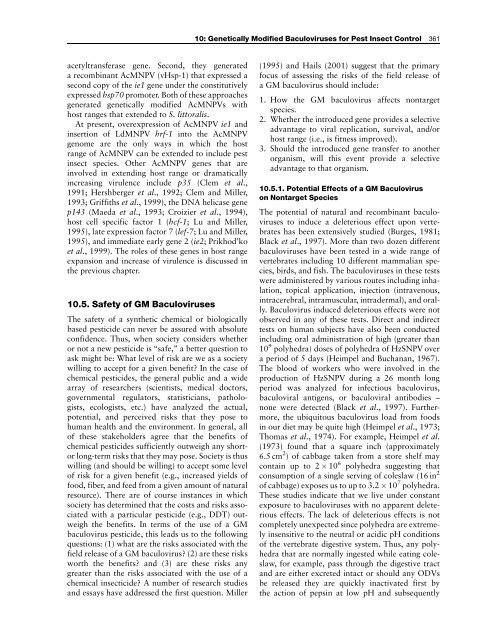Insect Control: Biological and Synthetic Agents - Index of
Insect Control: Biological and Synthetic Agents - Index of
Insect Control: Biological and Synthetic Agents - Index of
Create successful ePaper yourself
Turn your PDF publications into a flip-book with our unique Google optimized e-Paper software.
acetyltransferase gene. Second, they generated<br />
a recombinant AcMNPV (vHsp-1) that expressed a<br />
second copy <strong>of</strong> the ie1 gene under the constitutively<br />
expressed hsp70 promoter. Both <strong>of</strong> these approaches<br />
generated genetically modified AcMNPVs with<br />
host ranges that extended to S. littoralis.<br />
At present, overexpression <strong>of</strong> AcMNPV ie1 <strong>and</strong><br />
insertion <strong>of</strong> LdMNPV hrf-1 into the AcMNPV<br />
genome are the only ways in which the host<br />
range <strong>of</strong> AcMNPV can be extended to include pest<br />
insect species. Other AcMNPV genes that are<br />
involved in extending host range or dramatically<br />
increasing virulence include p35 (Clem et al.,<br />
1991; Hershberger et al., 1992; Clem <strong>and</strong> Miller,<br />
1993; Griffiths et al., 1999), the DNA helicase gene<br />
p143 (Maeda et al., 1993; Croizier et al., 1994),<br />
host cell specific factor 1 (hcf-1; Lu <strong>and</strong> Miller,<br />
1995), late expression factor 7 (lef-7; Lu <strong>and</strong> Miller,<br />
1995), <strong>and</strong> immediate early gene 2 (ie2; Prikhod’ko<br />
et al., 1999). The roles <strong>of</strong> these genes in host range<br />
expansion <strong>and</strong> increase <strong>of</strong> virulence is discussed in<br />
the previous chapter.<br />
10.5. Safety <strong>of</strong> GM Baculoviruses<br />
The safety <strong>of</strong> a synthetic chemical or biologically<br />
based pesticide can never be assured with absolute<br />
confidence. Thus, when society considers whether<br />
or not a new pesticide is ‘‘safe,’’ a better question to<br />
ask might be: What level <strong>of</strong> risk are we as a society<br />
willing to accept for a given benefit? In the case <strong>of</strong><br />
chemical pesticides, the general public <strong>and</strong> a wide<br />
array <strong>of</strong> researchers (scientists, medical doctors,<br />
governmental regulators, statisticians, pathologists,<br />
ecologists, etc.) have analyzed the actual,<br />
potential, <strong>and</strong> perceived risks that they pose to<br />
human health <strong>and</strong> the environment. In general, all<br />
<strong>of</strong> these stakeholders agree that the benefits <strong>of</strong><br />
chemical pesticides sufficiently outweigh any shortor<br />
long-term risks that they may pose. Society is thus<br />
willing (<strong>and</strong> should be willing) to accept some level<br />
<strong>of</strong> risk for a given benefit (e.g., increased yields <strong>of</strong><br />
food, fiber, <strong>and</strong> feed from a given amount <strong>of</strong> natural<br />
resource). There are <strong>of</strong> course instances in which<br />
society has determined that the costs <strong>and</strong> risks associated<br />
with a particular pesticide (e.g., DDT) outweigh<br />
the benefits. In terms <strong>of</strong> the use <strong>of</strong> a GM<br />
baculovirus pesticide, this leads us to the following<br />
questions: (1) what are the risks associated with the<br />
field release <strong>of</strong> a GM baculovirus? (2) are these risks<br />
worth the benefits? <strong>and</strong> (3) are these risks any<br />
greater than the risks associated with the use <strong>of</strong> a<br />
chemical insecticide? A number <strong>of</strong> research studies<br />
<strong>and</strong> essays have addressed the first question. Miller<br />
10: Genetically Modified Baculoviruses for Pest <strong>Insect</strong> <strong>Control</strong> 361<br />
(1995) <strong>and</strong> Hails (2001) suggest that the primary<br />
focus <strong>of</strong> assessing the risks <strong>of</strong> the field release <strong>of</strong><br />
a GM baculovirus should include:<br />
1. How the GM baculovirus affects nontarget<br />
species.<br />
2. Whether the introduced gene provides a selective<br />
advantage to viral replication, survival, <strong>and</strong>/or<br />
host range (i.e., is fitness improved).<br />
3. Should the introduced gene transfer to another<br />
organism, will this event provide a selective<br />
advantage to that organism.<br />
10.5.1. Potential Effects <strong>of</strong> a GM Baculovirus<br />
on Nontarget Species<br />
The potential <strong>of</strong> natural <strong>and</strong> recombinant baculoviruses<br />
to induce a deleterious effect upon vertebrates<br />
has been extensively studied (Burges, 1981;<br />
Black et al., 1997). More than two dozen different<br />
baculoviruses have been tested in a wide range <strong>of</strong><br />
vertebrates including 10 different mammalian species,<br />
birds, <strong>and</strong> fish. The baculoviruses in these tests<br />
were administered by various routes including inhalation,<br />
topical application, injection (intravenous,<br />
intracerebral, intramuscular, intradermal), <strong>and</strong> orally.<br />
Baculovirus induced deleterious effects were not<br />
observed in any <strong>of</strong> these tests. Direct <strong>and</strong> indirect<br />
tests on human subjects have also been conducted<br />
including oral administration <strong>of</strong> high (greater than<br />
10 9 polyhedra) doses <strong>of</strong> polyhedra <strong>of</strong> HzSNPV over<br />
a period <strong>of</strong> 5 days (Heimpel <strong>and</strong> Buchanan, 1967).<br />
The blood <strong>of</strong> workers who were involved in the<br />
production <strong>of</strong> HzSNPV during a 26 month long<br />
period was analyzed for infectious baculovirus,<br />
baculoviral antigens, or baculoviral antibodies –<br />
none were detected (Black et al., 1997). Furthermore,<br />
the ubiquitous baculovirus load from foods<br />
in our diet may be quite high (Heimpel et al., 1973;<br />
Thomas et al., 1974). For example, Heimpel et al.<br />
(1973) found that a square inch (approximately<br />
6.5 cm 2 ) <strong>of</strong> cabbage taken from a store shelf may<br />
contain up to 2 10 6 polyhedra suggesting that<br />
consumption <strong>of</strong> a single serving <strong>of</strong> coleslaw (16 in 2<br />
<strong>of</strong> cabbage) exposes us to up to 3.2 10 7 polyhedra.<br />
These studies indicate that we live under constant<br />
exposure to baculoviruses with no apparent deleterious<br />
effects. The lack <strong>of</strong> deleterious effects is not<br />
completely unexpected since polyhedra are extremely<br />
insensitive to the neutral or acidic pH conditions<br />
<strong>of</strong> the vertebrate digestive system. Thus, any polyhedra<br />
that are normally ingested while eating coleslaw,<br />
for example, pass through the digestive tract<br />
<strong>and</strong> are either excreted intact or should any ODVs<br />
be released they are quickly inactivated first by<br />
the action <strong>of</strong> pepsin at low pH <strong>and</strong> subsequently










